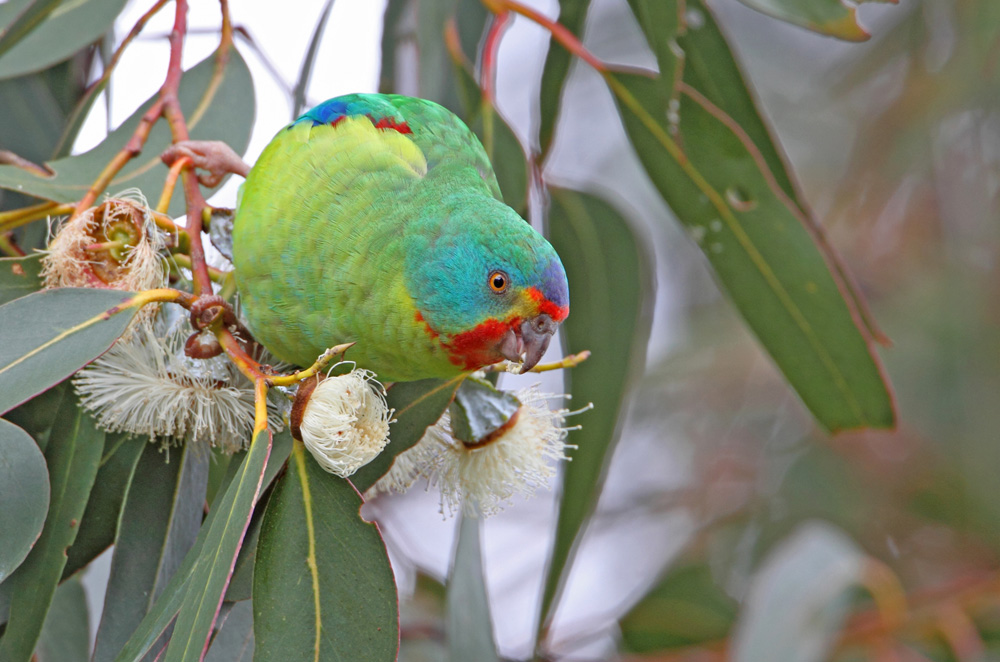Securing the Swift Parrot
Aim
The “Securing the Swift Parrot” project aims to stabilise or improve the trajectory of the Swift Parrot by 2023. The Swift Parrot has suffered from Woodland clearing and are nationally listed as Critically Endangered.
The project will increase the knowledge of the abundance of birds and their location within the Central West. This project will enhance and restore Swift Parrot foraging habitat through grazing management, pest animal control, and weed control on private and public land.
The Swift Parrot are unique as it feeds in the Central West during winter on our flowering Eucalypts and Ironbarks, then flies to Tasmania to breed over Summer.
The priority areas for Swift Parrot conservation stretch from Coonabarabran to Grenfell along the eastern side of the Central West region.
Species overview

The Swift Parrot is a slim, medium-sized parrot about 25cm long. Its body is mostly bright green, with a dark blue patch on the crown. The forehead to throat is crimson and there is a crimson patch at the bend of the wing. One of its most distinctive features from a distance is its long (12cm), thin tail, which is dark red, setting it apart from other Lorikeets and Parrots.
The Swift Parrot is found only in south-eastern Australia, migrating to Tasmania to breed in September to January. It is found mainly in southern and central Victoria in winter and also in eastern New South Wales.
Swift Parrot feeds mainly on nectar of the Swamp Mahogany, Spotted Gum, Red Bloodwood, Forest Red Gum, Mugga Ironbark, and White Box. It can also feed on insects and spiders, as well as native and cultivated fruits.
While on the mainland, they are nomadic, determined by the supply of nectar. During dry years, when the Eucalypts’ flowering is poor, Swift Parrots are forced to travel far and wide to find sufficient food.
Image: Swift Parrot in tree. Credit: Chris Tzaros
Why is it threatened
Loss of key Eucalypt habitat and foraging tree species contributes to the population decline of the species. Lowland fertile woodland areas have been cleared for agriculture and residential activity, reducing the extent of foraging habitat.
High fire frequency and drought conditions can impact on food resource availability. Swift Parrot are subject to predation by feral animals and exclusion from food sources by other aggressive bird species.
Case study: Securing the Swift Parrot – Therese and Kevin Welsh
Before Kevin and Therese Welsh submitted an expression of interest after reading about the Swift Parrot in their Local Land Services newsletter, they had never heard of the critically endangered Swift Parrot.
Fast forward two years and the Welsh’s have turned one of their creeks on their property “Round Range” near Eugowra in Central West NSW into an ecological haven for the Swift Parrot and other native plant and animal species.
How you can help
The project will be undertaken in collaboration with Birdlife Australia and the Department of Planning, Industry and Environment. A key outcome of the project is to increase understanding and capacity of the community to be able to identify the Swift Parrot and assist in recording sightings in the Central West.
- The community can get involved through community events, or by bringing your binoculars and participating in our bird surveys during Autumn and Spring.
- You can record Swift Parrot sightings through the Birdata website or app.
This project is supported by Central West Local Land Services, through funding from the Australian Government’s National Landcare Program.
Project contact
For further information, please contact your local natural resource management team member on 1300 795 299.